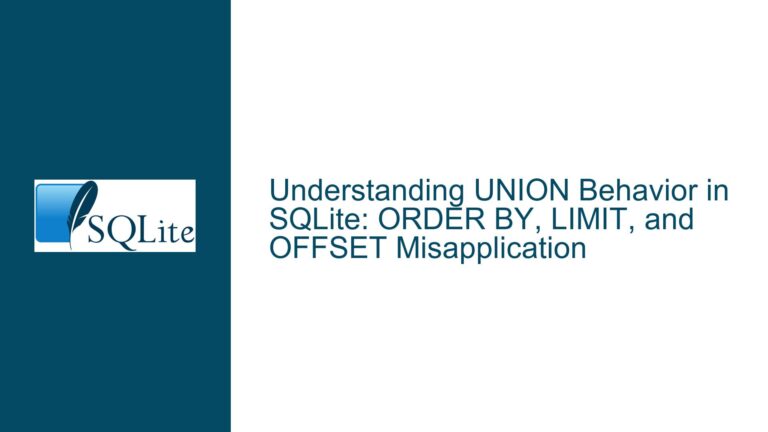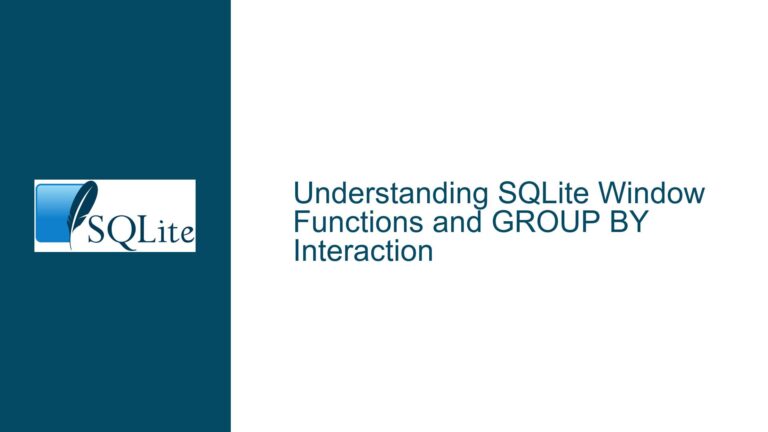NULL Handling in SQLite IN and NOT IN Subqueries
The Impact of NULL Values on IN and NOT IN Subquery Evaluation in SQLite
Core Challenge: NULL Semantics in Subqueries Trigger Unexpected Filtering Behavior
When working with SQLite’s IN and NOT IN operators containing subqueries that may return NULL values, developers often encounter counterintuitive results due to SQL’s three-valued logic implementation. A common manifestation occurs when a NULL presence in the right-hand side (RHS) of these operators causes entire query clauses to evaluate to NULL rather than TRUE/FALSE, effectively filtering out rows that developers expect to see. This behavior stems from SQL’s strict adherence to NULL handling rules defined in the SQL-92 standard, which SQLite implements with specific nuances outlined in its documentation.
The fundamental challenge lies in reconciling developer expectations of binary logic (TRUE/FALSE outcomes) with SQL’s three-valued logic (TRUE/FALSE/UNKNOWN). When subqueries return at least one NULL value, the comparison logic enters NULL propagation mode, where any comparison involving NULL yields NULL. For WHERE clauses that require a TRUE condition to include rows, this NULL evaluation acts as an implicit filter, creating scenarios where queries return fewer rows than anticipated—or none at all—when NULL values exist in the comparison set.
Root Causes: Three-Valued Logic and NULL Propagation Mechanisms
1. SQL Standard Compliance with Three-Valued Logic
SQLite strictly implements ANSI SQL’s three-valued logic system where:
- TRUE represents successful comparison
- FALSE represents failed comparison
- NULL (UNKNOWN) represents indeterminate comparisons
This becomes particularly impactful with IN and NOT IN operators when the subquery contains NULL values. The operator’s output transforms into a three-state evaluation rather than simple set membership check. For 1 NOT IN (2,3,NULL), SQLite evaluates this as NOT (1=2 OR 1=3 OR 1=NULL). Since 1=NULL evaluates to NULL, the entire OR chain becomes NULL through NULL propagation rules, and NOT NULL remains NULL.
2. NULL Handling in Subquery Result Sets
When a subquery returns multiple rows containing at least one NULL value, SQLite applies NULL comparison semantics to the entire operator evaluation. The presence of a single NULL in the RHS set converts the comparison outcome to NULL regardless of other values. This occurs because SQL evaluates value IN (subquery) as a series of OR-connected equality checks between the target value and each subquery result row. If any comparison in this chain yields NULL, the entire expression’s truth value becomes indeterminate.
3. Implicit WHERE Clause Filtering
SQL’s WHERE clause only returns rows where the condition evaluates to TRUE. When a NOT IN subquery containing NULL evaluates to NULL, those rows get excluded from result sets. Developers expecting FALSE outcomes (which would include the row) instead get NULL evaluations that functionally exclude the row, creating the illusion that "NULL matches all" when in reality it creates an indeterminate state that fails the WHERE clause’s truth requirement.
Resolution Strategy: NULL Mitigation and Alternative Approaches
1. Subquery NULL Elimination
Modify subqueries to explicitly exclude NULL values using IS NOT NULL filters:
SELECT 'B', 1
WHERE 1 NOT IN (SELECT val FROM subquery WHERE val IS NOT NULL);
This prevents NULL contamination in the comparison set, forcing the IN/NOT IN operator to work with only concrete values. For subqueries returning multiple columns, apply NULL checks to all relevant columns.
2. COALESCE Function for Default Values
Convert potential NULLs to specific marker values using COALESCE:
SELECT 'B', 1
WHERE 1 NOT IN (SELECT COALESCE(val, -999) FROM subquery);
Choose a default value (-999 in this example) that doesn’t exist in the legitimate data range. This approach maintains row inclusion in the comparison while neutralizing NULL’s impact.
3. EXISTS Operator Substitution
Replace NOT IN with NOT EXISTS correlated subquery that explicitly handles NULL:
SELECT 'B', 1
WHERE NOT EXISTS (
SELECT 1 FROM subquery
WHERE subquery.val = 1
);
The EXISTS operator stops evaluating on first match and doesn’t propagate NULL in the same way as IN. This approach often yields better performance and clearer NULL handling.
4. LEFT JOIN Anti-Pattern Technique
Use left joins to identify non-matching records:
SELECT 'B', 1
LEFT JOIN subquery ON subquery.val = 1
WHERE subquery.val IS NULL;
This traditional SQL pattern avoids NOT IN entirely while providing explicit control over NULL handling through join conditions.
5. CASE-Based NULL Handling
Wrap the comparison in a CASE statement that converts NULL to explicit boolean logic:
SELECT 'B', 1
WHERE CASE
WHEN 1 NOT IN (SELECT val FROM subquery) THEN 1
ELSE 0
END = 1;
While more verbose, this allows explicit control over how NULL evaluations get treated in the filter logic.
6. Permanent Schema Design Solutions
For persistent NULL-related issues, consider schema modifications:
- Add
NOT NULLconstraints to columns involved in frequent comparisons - Use DEFAULT values that replace NULL with application-specific neutral values
- Implement check constraints to prevent invalid NULL insertions
7. Query Planner Optimization
Analyze the query plan using EXPLAIN QUERY PLAN to understand how NULL handling affects execution:
EXPLAIN QUERY PLAN
SELECT 'B', 1 WHERE 1 NOT IN (SELECT NULL UNION SELECT 7);
Look for SCAN operations that might indicate full table scans due to NULL uncertainty, then add appropriate indexes or restructure queries to improve performance.
8. Three-Valued Logic Awareness Training
Developers should internalize these evaluation rules through targeted practice:
- NULL comparisons always yield NULL (
NULL = 1→ NULL) - Logical operators with NULL inputs:
TRUE AND NULL→ NULLFALSE OR NULL→ NULLNOT NULL→ NULL
- Aggregate functions ignore NULL except COUNT(*)
9. SQLite-Specific Configuration Options
While SQLite doesn’t provide configuration flags to alter NULL handling semantics, developers can:
- Create user-defined functions to customize comparison behavior
- Use VIEWs to encapsulate NULL handling logic
- Implement trigger-based NULL cleansing for critical tables
10. Comprehensive Testing Strategy
Implement test cases covering all NULL scenarios:
-- Test case 1: No NULLs in subquery
SELECT 1 WHERE 1 NOT IN (2,3,4); -- Returns 1
-- Test case 2: NULL present in subquery
SELECT 1 WHERE 1 NOT IN (2,NULL); -- Returns empty
-- Test case 3: Subquery returns only NULL
SELECT 1 WHERE 1 NOT IN (SELECT NULL); -- Returns empty
-- Test case 4: NULL handling with COALESCE
SELECT 1 WHERE 1 NOT IN (SELECT COALESCE(NULL,2)); -- Returns empty
11. Performance Considerations
NULL handling impacts query optimization:
- Queries with
NOT INand NULLable subqueries prevent index usage - SQLite cannot use indexes for
IS NULLchecks in partial indexes - Materializing subquery results with temp tables may help in complex cases
12. Cross-Database Comparison
While focusing on SQLite, note other RDBMS variations:
- MySQL: Behaves similarly but with different optimization paths
- PostgreSQL: Strict standards compliance with more NULL handling options
- Oracle: Provides NULL-related functions like NVL2 for complex handling
13. Advanced Use Case: NULL-Safe Comparisons
For scenarios requiring explicit NULL matching, use:
SELECT 'B', 1
WHERE NOT EXISTS (
SELECT 1 FROM subquery
WHERE subquery.val IS 1 -- Uses IS instead of = for NULL safety
);
The IS operator provides TRUE/FALSE outcomes even with NULL values (NULL IS NULL → TRUE).
14. Historical Context and Design Rationale
SQL’s three-valued logic dates back to the 1970s Codd’s relational model, designed to handle missing information without assuming semantics. SQLite maintains this tradition while optimizing for embedded use cases where strict NULL handling prevents data corruption in low-memory environments.
15. Debugging Methodology
Systematic approach to NULL-related query issues:
- Identify all subqueries in
IN/NOT INclauses - Check for NULLable columns in subquery SELECT list
- Run subquery independently to verify NULL presence
- Add temporary
WHERE column IS NOT NULLclauses to test - Gradually reintroduce complexity while monitoring result changes
16. Client-Side Handling Options
When schema/query changes aren’t feasible, implement application logic:
- Post-process query results to filter NULL-affected rows
- Use ORM hooks to automatically clean NULL values
- Implement caching layers for frequent NULL-containing queries
17. Documentation Cross-Reference
Key SQLite documentation sections:
- lang_expr.html: Expression handling including NULL
- datatype3.html: NULL type fundamentals
- queryplanner.html: How NULL affects index usage
- lang_aggfunc.html: NULL handling in aggregate functions
18. Community Wisdom and Anti-Patterns
Common misconceptions to avoid:
- "Adding more WHERE clauses will fix NULL issues" (May compound the problem)
- "COALESCE in all queries prevents NULL problems" (Can mask legitimate NULL values)
- "NOT IN is always equivalent to NOT EXISTS" (Different NULL handling makes them non-interchangeable)
19. Long-Term Maintenance Strategy
- Implement database linting rules for NULL handling
- Use static analysis tools to detect risky NULL patterns
- Include NULL test cases in all query-related unit tests
- Document NULL policies for critical comparison columns
20. Philosophical Approach to NULL Management
Treat NULL as a first-class citizen in database design:
- Explicitly define NULL meaning per column (Missing vs Unknown vs Not Applicable)
- Establish NULL handling conventions across development teams
- Consider alternative designs (separate flag columns, sparse tables) where NULL semantics become problematic
This comprehensive approach enables developers to master SQLite’s NULL handling in subqueries, transforming what initially appears as confusing behavior into predictable, manageable outcomes through rigorous schema design, query construction, and continuous validation practices.






